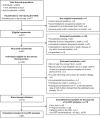Population-based study of high plasma C-reactive protein concentrations among the Inuit of Nunavik
- PMID: 23087913
- PMCID: PMC3475996
- DOI: 10.3402/ijch.v71i0.19066
Population-based study of high plasma C-reactive protein concentrations among the Inuit of Nunavik
Abstract
Background: The shift away from traditional lifestyle in the Inuit population over the past few decades has been associated with an increased prevalence of coronary heart disease (CHD) risk factors such as obesity, high blood pressure (BP) and diabetes. However, the impact of this transition on the pro-inflammatory marker high-sensitivity C-reactive protein (hs-CRP) has not been documented.
Objectives: To examine the prevalence of elevated plasma hs-CRP concentrations in Inuit from Nunavik in the province of Quebec (Canada) and identify anthropometric, biochemical and lifestyle risk factors associated with elevated hs-CRP.
Design: A population-representative sample of 801 Inuit residents from 14 villages of Nunavik, aged between 18 and 74 years, was included in the analyses. Subjects participated in a clinical session and completed questionnaires on lifestyle. Multivariate logistic regression was used to determine risk factors for elevated hs-CRP.
Results: Elevated plasma hs-CRP concentrations (≥ 2 mg/L) were present in 32.7% (95% confidence interval (CI) 29.5-35.8) of the Inuit adult population and were more prevalent among women than among men (36.7% vs. 29.0%, p=0.007). Multivariate logistic regression analysis indicated that every 1 mmHg increase in systolic BP was associated with a 3% increase in the odds of having hs-CRP concentrations ≥ 2 mg/L in the Inuit population (95% CI 1.01-1.04). The combination of older age (≥ 50 vs. <30 years) and elevated waist circumference (gender-specific cut-off values) in a multivariate logistic model was also associated with a 13.3-fold increase in the odds of having plasma hs-CRP concentrations ≥ 2 mg/L (95% CI 5.8-30.9).
Conclusions: These data indicate that elevated hs-CRP is relatively prevalent among Inuit with values that are similar to those seen in Canadian Caucasian populations. Sex, age, waist circumference and systolic BP are major factors that increase the risk of this inflammatory phenotype among Inuit from Nunavik, despite their different lifestyle background compared with Caucasians.
Keywords: C-reactive protein; Inuit; Nunavik; aging; prevalence; risk factors; sex; systolic blood pressure; waist circumference.
Figures



Similar articles
-
Prevalence and determinants of hypertension in the adult Inuit population of Nunavik (northern Quebec, Canada).Can J Public Health. 2024 Jan;115(Suppl 1):168-179. doi: 10.17269/s41997-023-00774-5. Epub 2023 May 8. Can J Public Health. 2024. PMID: 37155001 Free PMC article.
-
Cardiovascular burden and related risk factors among Nunavik (Quebec) Inuit: insights from baseline findings in the circumpolar Inuit health in transition cohort study.Can J Cardiol. 2010 Jun-Jul;26(6):190-6. doi: 10.1016/s0828-282x(10)70398-6. Can J Cardiol. 2010. PMID: 20548980 Free PMC article.
-
Traditional dietary pattern is associated with elevated cholesterol among the Inuit of Nunavik.J Acad Nutr Diet. 2014 Aug;114(8):1208-1215.e3. doi: 10.1016/j.jand.2013.12.017. Epub 2014 Feb 13. J Acad Nutr Diet. 2014. PMID: 24529977
-
Nunavimmi puvakkut kaggutimik aanniaqarniq: Qanuilirqitaa? Lung cancer in Nunavik: How are we doing? A retrospective matched cohort study.CMAJ. 2024 Feb 19;196(6):E177-E186. doi: 10.1503/cmaj.230682. CMAJ. 2024. PMID: 38378218 Free PMC article. Review.
-
Cardiovascular Disease Susceptibility and Resistance in Circumpolar Inuit Populations.Can J Cardiol. 2015 Sep;31(9):1116-23. doi: 10.1016/j.cjca.2015.06.002. Epub 2015 Jun 11. Can J Cardiol. 2015. PMID: 26239003 Review.
Cited by
-
Association of red blood cell n-3 polyunsaturated fatty acids with plasma inflammatory biomarkers among the Quebec Cree population.Eur J Clin Nutr. 2014 Sep;68(9):1042-7. doi: 10.1038/ejcn.2014.125. Epub 2014 Jul 16. Eur J Clin Nutr. 2014. PMID: 25028086
-
Association of ideal cardiovascular metrics and serum high-sensitivity C-reactive protein in hypertensive population.PLoS One. 2013 Dec 11;8(12):e81597. doi: 10.1371/journal.pone.0081597. eCollection 2013. PLoS One. 2013. PMID: 24349092 Free PMC article. Clinical Trial.
-
A comprehensive exploration of chronic kidney disease and dialysis in Canada's Indigenous population: from epidemiology to genetic influences.Int Urol Nephrol. 2024 Nov;56(11):3545-3558. doi: 10.1007/s11255-024-04122-5. Epub 2024 Jun 20. Int Urol Nephrol. 2024. PMID: 38898356 Review.
-
Overview of ongoing cohort and dietary studies in the Arctic.Int J Circumpolar Health. 2016 Dec 13;75:33803. doi: 10.3402/ijch.v75.33803. eCollection 2016. Int J Circumpolar Health. 2016. PMID: 27974135 Free PMC article.
-
Non-fasting changes of Hs-CRP level in Chinese patients with coronary heart disease after a daily meal.Sci Rep. 2022 Nov 1;12(1):18435. doi: 10.1038/s41598-022-20645-2. Sci Rep. 2022. PMID: 36319655 Free PMC article.
References
-
- Sharma S. Assessing diet and lifestyle in the Canadian Arctic Inuit and Inuvialuit to inform a nutrition and physical activity intervention programme. J Hum Nutr Diet. 2010;23(Suppl 1):5–17. - PubMed
-
- Dewailly E, Chateau-Degat ML, Ekoé JM, Ladouceur R, Rochette L. Québec, Canada: Gouvernement du Québec – Institut national de santé publique du Québec (INSPQ) & Nunavik Regional Board of Health and Social Services (NRBHSS); 2007. Status of cardiovascular disease and diabetes in Nunavik. Nunavik Inuit Health Survey 2004, Qanuippitaa? How are we?
-
- Chateau-Degat ML, Dewailly E, Charbonneau G, Laouan-Sidi EA, Tremblay A, Egeland GM. Obesity risks: towards an emerging Inuit pattern. Int J Circumpolar Health. 2011;70:166–77. - PubMed
-
- Ayach BB, Korda H. Commentary: type 2 diabetes epidemic in first nations people of Canada. Ethn Dis. 2010;20:300–3. - PubMed
-
- Koenig W, Sund M, Frohlich M, Fischer HG, Lowel H, Doring A, et al. C-reactive protein, a sensitive marker of inflammation, predicts future risk of coronary heart disease in initially healthy middle-aged men – results from the MONICA (Monitoring Trends and Determinants in Cardiovascular Disease) Augsburg cohort study, 1984 to 1992. Circulation. 1999;99:237–42. - PubMed
Publication types
MeSH terms
Substances
Grants and funding
LinkOut - more resources
Full Text Sources
Medical
Research Materials
Miscellaneous
